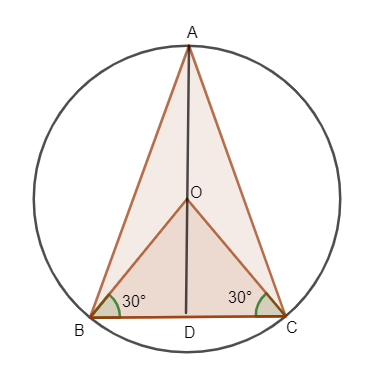
An equilateral triangle is inscribed in a circle of radius 6cm. Find its side.
Answer
530.7k+ views
1 likes
Hint: Draw the figure. The line connecting the centre of the circle to the vertex of the triangle is taken as radius. Draw perpendicular to the base of the triangle. Solve the triangle using Pythagoras theorem and find the length of the side.
Complete step-by-step answer:
Let ABC be an equilateral triangle inscribed in a circle of radius of 6cm.
Let us consider O as the centre of the circle.

OA, OB and OC correspond to the radius of the circle.
OA=OB=OC=r
OA=OB=OC=6cm.
Let OD be a perpendicular from 0 to side BC.
So D becomes the mid-point of BC. So, OB and OC are bisectors of
For an Equilateral triangle all angles as
As OB and OC bisects angle
Now let us consider
We know the angle=
By using basic trigonometry we know that,
We know,
BC=2BD
Because
Length BD=length DC.
Total length BC= BD+DC.
BC=BD+BC
BC=2BD
BC=
As it is an equilateral triangle,
AB=BC=AC=
Note: If the question was given for isosceles triangle instead of equilateral triangle, the OA
Complete step-by-step answer:
Let ABC be an equilateral triangle inscribed in a circle of radius of 6cm.
Let us consider O as the centre of the circle.

OA, OB and OC correspond to the radius of the circle.
OA=OB=OC=r
OA=OB=OC=6cm.
Let OD be a perpendicular from 0 to side BC.
So D becomes the mid-point of BC. So, OB and OC are bisectors of
For an Equilateral triangle all angles as
As OB and OC bisects angle
Now let us consider
We know the angle=
By using basic trigonometry we know that,
We know,
BC=2BD
Because
Length BD=length DC.
Total length BC= BD+DC.
BC=BD+BC
BC=2BD
BC=
As it is an equilateral triangle,
AB=BC=AC=
Note: If the question was given for isosceles triangle instead of equilateral triangle, the OA
Recently Updated Pages
Master Class 11 Economics: Engaging Questions & Answers for Success

Master Class 11 Business Studies: Engaging Questions & Answers for Success

Master Class 11 Accountancy: Engaging Questions & Answers for Success

Master Class 11 English: Engaging Questions & Answers for Success

Master Class 11 Computer Science: Engaging Questions & Answers for Success

Master Class 11 Maths: Engaging Questions & Answers for Success

Trending doubts
State and prove Bernoullis theorem class 11 physics CBSE

1 ton equals to A 100 kg B 1000 kg C 10 kg D 10000 class 11 physics CBSE

State the laws of reflection of light

One Metric ton is equal to kg A 10000 B 1000 C 100 class 11 physics CBSE

Difference Between Prokaryotic Cells and Eukaryotic Cells

1 Quintal is equal to a 110 kg b 10 kg c 100kg d 1000 class 11 physics CBSE




